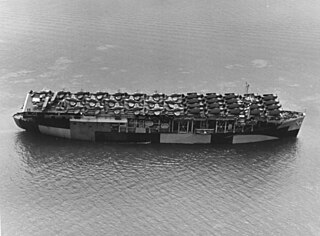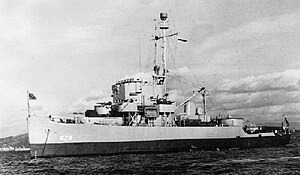
USS Long Island (CVE-1) was lead ship of her class and the first escort carrier of the United States Navy. She was also the second ship to be named after Long Island, New York.
The first USS Shreveport (PG-131/PF-23) was a Tacoma-class frigate of the United States Navy.

The first USS Turner (DD-259) was a Clemson-class destroyer in commission in the United States Navy from 1919 to 1922. She served in a non-commissioned status as the water lighter YW-56 from 1936 to 1943, and was in commission as a miscellaneous auxiliary, the second USS Moosehead (IX-98), from 1943 to 1946.
USS Execute (AM-232) was an Admirable-class minesweeper built for the United States Navy during World War II. She was originally ordered and laid down as USS PCE-905, the lead ship of the PCE-905 class of patrol craft. She was reclassified as an Admirable-class minesweeper by the time of her June 1944 launch, and named Execute by the time of her November 1944 commissioning. After service in the Pacific during World War II, she was decommissioned in August 1946 and placed in reserve. While she remained in reserve, Execute was reclassified as MSF-232 in February 1955 but never reactivated. In 1962, she was sold to the Mexican Navy and renamed ARM DM-03. In 1994, she was renamed ARM General Juan N. Méndez (C51). She was stricken in July 2001, but her ultimate fate is not reported in secondary sources.

USS Ampere (PCE-919/AM-359/YDG-11/ADG-11) was originally planned as a PCE-905-class patrol craft for the United States Navy, PCE-919, and laid down as an Admirable-class minesweeper, named Drake, for the male duck. Before she was commissioned, her name was cancelled and she was reclassified as a District Degaussing Vessel. She was later renamed Ampere, after the ampere, a unit of electric current, which takes its name from the French physicist André-Marie Ampère.
The third USS Magnet (ADG-9) was a degaussing vessel of the United States Navy, named after the magnet. Originally planned as a patrol craft escort (PCE-879), she was laid down on 27 May 1943 by the Albina Engine & Machine Works of Portland, Oregon; launched 30 September 1943; reclassified YDG-9 on 23 December 1943; and commissioned 10 July 1944.
USS Dextrous (AM-341) was an Auk-class minesweeper built for the United States Navy which served in World War II, the Korean War, and beyond. She was later transferred to the Republic of Korea Navy where she served as ROKS Koje (PCE-1003).
USS Buttress (PCE-878/ACM-4) was an auxiliary minelayer (ACM) in the United States Navy during World War II. This ship and USS Monadnock (ACM-10) were the only ACMs not previously U.S. Army mineplanters.
USS Facility (AM-233) was an Admirable-class minesweeper built for the United States Navy during World War II. The ship was ordered and laid down as PCE-905-class patrol craft USS PCE-906 but was renamed and reclassified before her June 1944 launch as Facility (AM-233). After earning three battle stars for service in the Pacific during World War II, she was decommissioned in September 1946 and placed in reserve. While in reserve, Facility was reclassified as MSF-233 in February 1955 but never reactivated. In October 1962, she was sold to the Mexican Navy and renamed ARM DM-04. Her ultimate fate is not reported in secondary sources; she may have been out of service by April 1973 when another member of the Admirable class was acquired by the Mexican Navy and given the name DM-04.
USAS Report (AGP-289) was an Admirable-class minesweeper built for the United States Navy during World War II as USS Report (AM-289). Although completed in July 1945, before the end of hostilities, she was placed in reserve and never commissioned into the U.S. Navy. She was reclassified as MSF-289 in February 1955, but remained in reserve until she was struck from the Naval Vessel Register in 1963. She was transferred to the United States Army and served U.S. Army Intelligence from 1963 to 1967 as a motor torpedo boat tender. Report was returned to U.S. Navy custody and loaned to South Korea. As ROKS Kojin (PCE-50) in Republic of Korea Navy service, she served through 1970 and was scrapped in 1973.
USS Creddock (AM-356) was an Admirable-class minesweeper built for the United States Navy during World War II. The ship was ordered and laid down as PCE-905-class patrol craft USS PCE-916 but was renamed and reclassified before her July 1944 launch as Creddock (AM-356). Creddock was launched 22 July 1944 by Willamette Iron and Steel Works, Portland, Oregon; sponsored by Miss N. I. Schmidleys; and commissioned 18 December 1945. Creddock departed Astoria, Oregon, 6 January 1946 and arrived at San Diego, California, 4 days later. There she was placed out of commission in reserve 26 March 1946. Creddock was reclassified MSF-356 on 7 February 1955.
USS Dipper (AM-357) was an Admirable-class minesweeper built for the United States Navy during World War II. The ship was ordered and laid down as PCE-905-class patrol craft USS PCE-917 but was renamed and reclassified before her July 1944 launch as Dipper (AM-357). Dipper was launched 26 July 1944 by Willamette Iron and Steel Works, Portland, Oregon ; sponsored by Miss A. L. Gaffney; and commissioned 26 December 1945. Dipper sailed from Portland 11 January 1946 to join the U.S. 19th Fleet (Reserve) at San Diego, California, four days later. She provided various services for this group until placed out of commission in reserve 15 January 1947. She was reclassified MSF-357, 7 February 1955. Dipper was sold for scrap on 5 January 1961.
USS Gavia (AM-363) was an Admirable-class minesweeper built for the United States Navy during World War II. The ship was ordered and laid down as PCE-905-class patrol craft USS PCE-907 but was renamed and reclassified before her September 1943 launch as Gavia (AM-363). She earned two battle stars in service in the Pacific during World War II. In May 1946, she was turned over to the Republic of China for service with the Chinese Maritime Customs Service as Yung Chun. She was removed from service in June 1962.

USS Lamar (PCE-899)/USCGC Lamar (WTR-899) was a PCE-842-class patrol craft acquired by the U.S. Navy during World War II for the task of patrolling assigned ocean areas or protecting larger ships in convoy.

USS PGM-17 was a PGM-9-class motor gunboat built for the United States Navy during World War II. She was laid down and launched as USS PC-1189, a PC-461-class submarine chaser, but was renamed and reclassified before her November 1944 commissioning. She ran aground near Okinawa in May 1945. She was salvaged a month later, but was never repaired. She was towed to deep water and sunk in October 1945.

The Altair class destroyer tender was a class of three United States Navy destroyer tenders. These ships were built in Skinner & Eddy's Seattle shipyard as commercial cargo ships during World War I, and acquired by the Navy when the shipyard closed in 1921. All three served through World War II, and were decommissioned and scrapped shortly after the war.

USS PCS-1450, ex-PC-1450, was a United States Navy minesweeper in commission from 1944 to 1946. She saw service in the latter stages of World War II.
ROKS Dangpo was a patrol craft of the Republic of Korea Navy (ROKN). Originally built as USS PCE-842, a PCE-842-class patrol craft for the United States Navy during World War II. Dangpo was acquired by South Korea on 13 December 1961 and sunk by North Korean coastal artillery fire on 19 January 1967.

USS PCE-893 was a PCE-842-class patrol craft for the United States Navy during World War II. She was renamed Siboney(H 101) after being acquired by the Cuban Navy on 20 November 1947.

USS PCE-867 was a PCE-842-class patrol craft for the United States Navy during World War II. She was renamed ROCSYong Tai (PCE-41) and ROCS Shan Hai (PCE-62) after being acquired by the Republic of China Navy on 7 February 1948.









